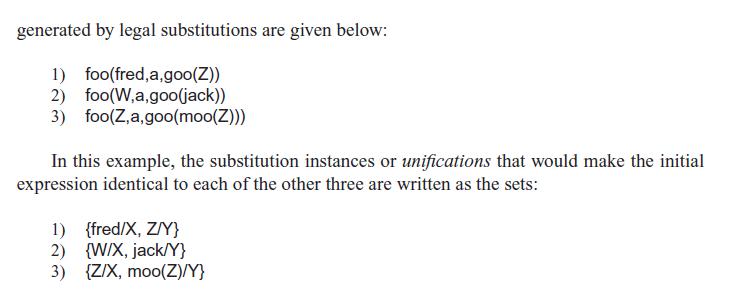Question: Implement the unify algorithm of Section 2.3.2 in the computer language of your choice. Data from section 2.3.2 To apply inference rules such as modus
Implement the unify algorithm of Section 2.3.2 in the computer language of your choice.
Data from section 2.3.2
To apply inference rules such as modus ponens, an inference system must be able to determine when two expressions are the same or match. In propositional calculus, this is trivial: two expressions match if and only if they are syntactically identical. In predicate calculus, the process of matching two sentences is complicated by the existence of variables in the expressions. Universal instantiation allows universally quantified variables to be replaced by terms from the domain. This requires a decision process for determining the variable substitutions under which two or more expressions can be made identical (usually for the purpose of applying inference rules).
Unification is an algorithm for determining the substitutions needed to make two predicate calculus expressions match. We have already seen this done in the previous subsection, where Socrates in man (Socrates) was substituted for X in ∀ X(man(X) ⇒ mortal(X)). This allowed the application of modus ponens and the conclusion mortal (Socrates). Another example of unification was seen previously when dummy variables were discussed. Because p(X) and p(Y) are equivalent, Y may be substituted for X to make the sentences match.
Unification and inference rules such as modus ponens allow us to make inferences on a set of logical assertions. To do this, the logical database must be expressed in an appropriate form.
An essential aspect of this form is the requirement that all variables be universally quantified. This allows full freedom in computing substitutions. Existentially quantified variables may be eliminated from sentences in the database by replacing them with the constants that make the sentence true. For example, ∃ X parent(X,tom) could be replaced by the expression parent(bob,tom) or parent(mary,tom), assuming that bob and mary are tom s parents under the interpretation.
The process of eliminating existentially quantified variables is complicated by the fact that the value of these substitutions may depend on the value of other variables in the expression. For example, in the expression ∀ X ∃ Y mother (X, Y), the value of the existentially quantified variable Y depends on the value of X.$3Skolemization replaces each existentially quantified variable with a function that returns the appropriate constant as a function of some or all of the other variables in the sentence. In the above example, because the value of Y depends on X, Y could be replaced by a skolem function, of X. $3 This yields the predicate ∀ X mother(X,f(X)). Skolemization, a process that can also bind universally quantified variables to constants, is discussed in more detail in Section 14.2.
Once the existentially quantified variables have been removed from a logical database, unification may be used to match sentences in order to apply inference rules such as modus ponens.
Unification is complicated by the fact that a variable may be replaced by any term, including other variables and function expressions of arbitrary complexity. These expressions may themselves contain variables. For example, father(jack) may be substituted for X in man(X) to infer that jack s father is mortal. Some instances of the expression:
![]()

foo(X,a,goo(Y)).
Step by Step Solution
3.42 Rating (155 Votes )
There are 3 Steps involved in it
The unification algorithm is a fundamental algorithm in symbolic artificial intelligence particularly in logic programming and automated theorem provi... View full answer

Get step-by-step solutions from verified subject matter experts


